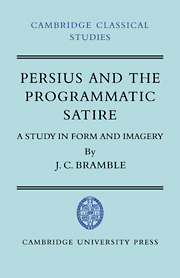Book contents
- Frontmatter
- Contents
- PARENTIBUS OPTIMIS
- Preface
- Abbreviations
- INTRODUCTION
- 1 STYLE AND EXPRESSION IN PERSIUS' FIFTH SATIRE
- 2 THE PROGRAMMATIC SATIRE AND THE METHOD OF PERSIUS I
- 3 THE NATURE AND SOURCES OF PERSIUS' IMAGERY
- 4 PERSIUS' FIRST SATIRE: ANALYSIS
- 5 GRANDEUR AND HUMILITY: JUVENAL AND THE HIGH STYLE
- APPENDIX 1 Accius and Pacuvius at Persius I. 76–8
- APPENDIX 2 Virgil and the moderns at Persius I. 96
- APPENDIX 3 The image of the child in ancient satire and diatribe
- APPENDIX 4 The disclaimer of malice
- TEXT
- TRANSLATION
- 1 INDEX OF MODERN AUTHORS
- 2 INDEX LOCORUM POTIORUM
- 3 INDEX OF IMAGES, TOPICS AND WORDS
3 - THE NATURE AND SOURCES OF PERSIUS' IMAGERY
from PARENTIBUS OPTIMIS
Published online by Cambridge University Press: 05 June 2014
- Frontmatter
- Contents
- PARENTIBUS OPTIMIS
- Preface
- Abbreviations
- INTRODUCTION
- 1 STYLE AND EXPRESSION IN PERSIUS' FIFTH SATIRE
- 2 THE PROGRAMMATIC SATIRE AND THE METHOD OF PERSIUS I
- 3 THE NATURE AND SOURCES OF PERSIUS' IMAGERY
- 4 PERSIUS' FIRST SATIRE: ANALYSIS
- 5 GRANDEUR AND HUMILITY: JUVENAL AND THE HIGH STYLE
- APPENDIX 1 Accius and Pacuvius at Persius I. 76–8
- APPENDIX 2 Virgil and the moderns at Persius I. 96
- APPENDIX 3 The image of the child in ancient satire and diatribe
- APPENDIX 4 The disclaimer of malice
- TEXT
- TRANSLATION
- 1 INDEX OF MODERN AUTHORS
- 2 INDEX LOCORUM POTIORUM
- 3 INDEX OF IMAGES, TOPICS AND WORDS
Summary
The most important, and most complex aspect of the metaphoric background to the first satire is that category of images and motifs which has simultaneous moral and literary force. For it is mainly from this that Persius elaborates his pose of satirist and critic of letters. But there are other, ancillary motifs, one moralistic, some literary-critical, which play a part in his programme. The various classes sometimes overlap, but in the majority of cases the divisions have a good degree of validity.
LITERARY-CRITICAL MOTIFS
Firstly, three complementary motifs which are predominantly relevant to the literary part of the campaign against mid-century Rome. Though in the first instance aimed directly at lack of taste, during the course of the satire they gather moral force.
EARS
Most prominent are the allusions to ears, their function one of indicting insensibility. Hendrickson has remarked that the ear is the medium for the reception of literature, and that Persius' question, nam Romae quis non, line 8, answered finally by auriculas asini quis non habet?, line 121, implies ‘who is a competent reader?’ To quote at length:
It is not enough to say, with Casaubon and the commentators, that this [sc. 121] is but a way of saying that all at Rome are asini, that is stulti, or as a mere variant of πας ἄφρων μαίνεται… the auriculae asini stand in direct relation to the question quis leget haec?
- Type
- Chapter
- Information
- Persius and the Programmatic SatireA Study in Form and Imagery, pp. 26 - 66Publisher: Cambridge University PressPrint publication year: 1974

